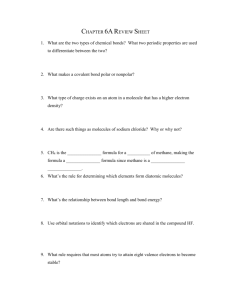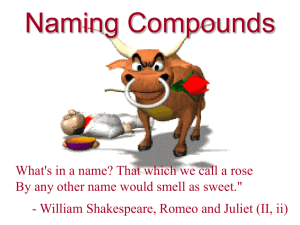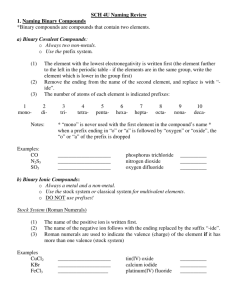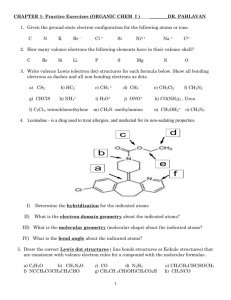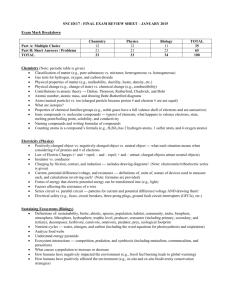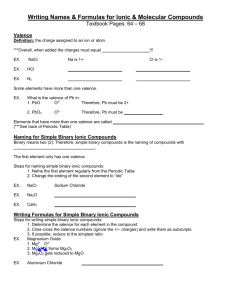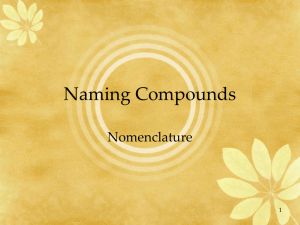Naming Ionic & Covalent Compounds - Valence
advertisement
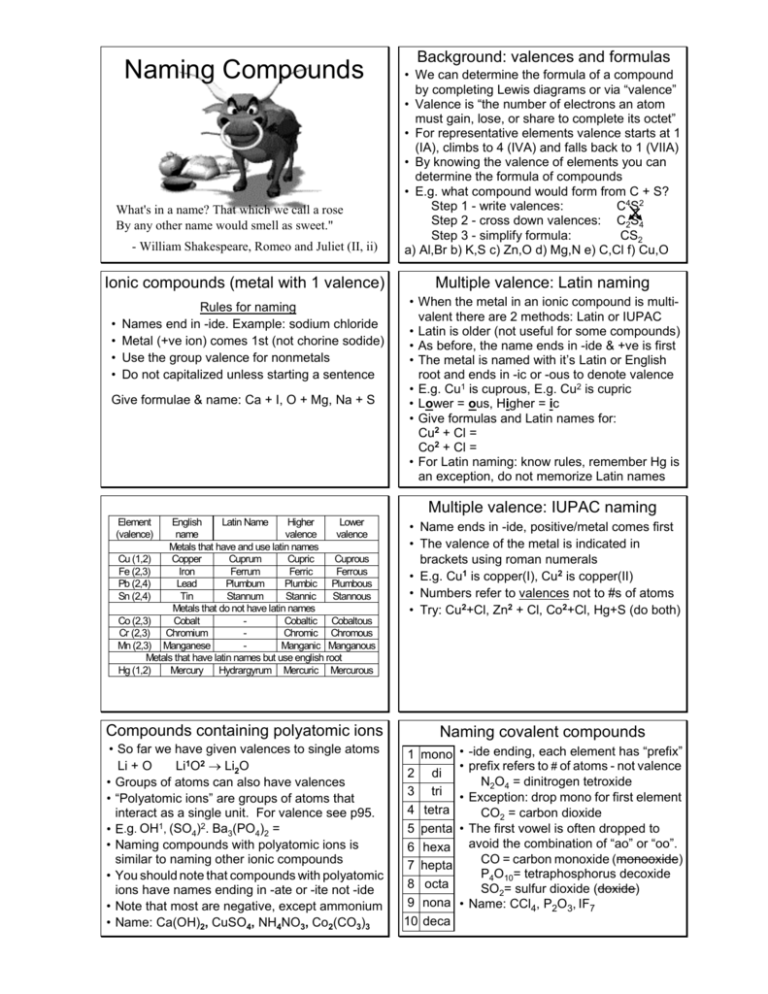
Naming Compounds What's in a name? That which we call a rose By any other name would smell as sweet." - William Shakespeare, Romeo and Juliet (II, ii) Ionic compounds (metal with 1 valence) • • • • Rules for naming Names end in -ide. Example: sodium chloride Metal (+ve ion) comes 1st (not chorine sodide) Use the group valence for nonmetals Do not capitalized unless starting a sentence Give formulae & name: Ca + I, O + Mg, Na + S Background: valences and formulas • We can determine the formula of a compound by completing Lewis diagrams or via “valence” • Valence is “the number of electrons an atom must gain, lose, or share to complete its octet” • For representative elements valence starts at 1 (IA), climbs to 4 (IVA) and falls back to 1 (VIIA) • By knowing the valence of elements you can determine the formula of compounds • E.g. what compound would form from C + S? Step 1 - write valences: C 4 S2 Step 2 - cross down valences: C2S4 Step 3 - simplify formula: CS2 a) Al,Br b) K,S c) Zn,O d) Mg,N e) C,Cl f) Cu,O Multiple valence: Latin naming • When the metal in an ionic compound is multivalent there are 2 methods: Latin or IUPAC • Latin is older (not useful for some compounds) • As before, the name ends in -ide & +ve is first • The metal is named with it’s Latin or English root and ends in -ic or -ous to denote valence • E.g. Cu1 is cuprous, E.g. Cu2 is cupric • Lower = ous, Higher = ic • Give formulas and Latin names for: Cu2 + Cl = Co2 + Cl = • For Latin naming: know rules, remember Hg is an exception, do not memorize Latin names Multiple valence: IUPAC naming Element (valence) English Latin Name Higher Lower name valence valence Metals that have and use latin names Cu (1,2) Copper Cuprum Cupric Cuprous Fe (2,3) Iron Ferrum Ferric Ferrous Pb (2,4) Lead Plumbum Plumbic Plumbous Sn (2,4) Tin Stannum Stannic Stannous Metals that do not have latin names Co (2,3) Cobalt Cobaltic Cobaltous Cr (2,3) Chromium Chromic Chromous Mn (2,3) Manganese Manganic Manganous Metals that have latin names but use english root Hg (1,2) Mercury Hydrargyrum Mercuric Mercurous • Name ends in -ide, positive/metal comes first • The valence of the metal is indicated in brackets using roman numerals • E.g. Cu1 is copper(I), Cu2 is copper(II) • Numbers refer to valences not to #s of atoms • Try: Cu2+Cl, Zn2 + Cl, Co2+Cl, Hg+S (do both) Compounds containing polyatomic ions Naming covalent compounds • So far we have given valences to single atoms Li + O Li1O2 → Li2O • Groups of atoms can also have valences • “Polyatomic ions” are groups of atoms that interact as a single unit. For valence see p95. • E.g. OH1, (SO4)2. Ba3(PO4)2 = • Naming compounds with polyatomic ions is similar to naming other ionic compounds • You should note that compounds with polyatomic ions have names ending in -ate or -ite not -ide • Note that most are negative, except ammonium • Name: Ca(OH)2, CuSO4, NH4NO3, Co2(CO3)3 1 mono 2 di 3 tri 4 tetra 5 penta 6 hexa 7 hepta 8 octa 9 nona 10 deca • -ide ending, each element has “prefix” • prefix refers to # of atoms - not valence N2O4 = dinitrogen tetroxide • Exception: drop mono for first element CO2 = carbon dioxide • The first vowel is often dropped to avoid the combination of “ao” or “oo”. CO = carbon monoxide (monooxide) P4O10= tetraphosphorus decoxide SO2= sulfur dioxide (doxide) • Name: CCl4, P2O3, IF7
